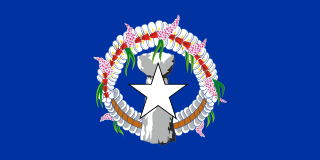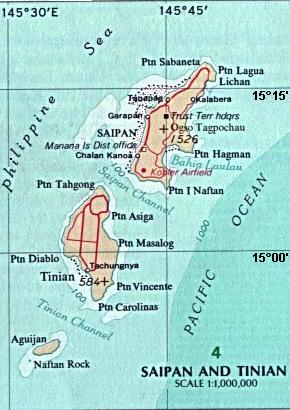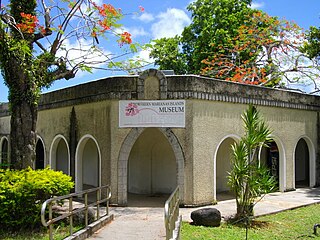Related Research Articles

The demographics of Guam details an array of demographic statistics relating to the territory of Guam. This includes statistics on population,including the Indigenous population;religious affiliations;language;and immigration. The Demographics of Guam provides an overview of the history of Guam,as well as a depiction of the villages in the United States territory and its populace. The population of Guam,as of July 2021 was 168,801.

Micronesia is a subregion of Oceania,consisting of approximately 2,000 small islands in the Northwestern Pacific Ocean. It has a close shared cultural history with three other island regions:Maritime Southeast Asia to the west,Polynesia to the east,and Melanesia to the south—as well as with the wider community of Austronesian peoples.

The Northern Mariana Islands,officially the Commonwealth of the Northern Mariana Islands (CNMI),is an unincorporated territory and commonwealth of the United States consisting of 14 islands in the northwestern Pacific Ocean. The CNMI includes the 14 northernmost islands in the Mariana Archipelago;the southernmost island,Guam is a U.S. territory. The Northern Mariana Islands were listed by the United Nations as a non-self-governing territory until 1990.

Saipan is the largest island and capital of the Northern Mariana Islands,a Territory of the United States in the western Pacific Ocean. According to 2020 estimates by the United States Census Bureau,the population of Saipan was 43,385. Its people have been United States citizens since the 1980s. Saipan is one of the main homes of the Chamorro,the Indigenous people of the Mariana Islands.

Tinian is one of the three principal islands of the Commonwealth of the Northern Mariana Islands (CNMI). Together with uninhabited neighboring Aguiguan,it forms Tinian Municipality,one of the four constituent municipalities of the Northern Marianas. Tinian's largest village is San Jose. Tinian is just south of the Northern Marianas' most inhabited island,Saipan,but north of the populated Rota to the south. The island has many World War II historical sites,cattle ranches,and beaches. There was a 5-star casino that operated from 1998 to 2015;the remaining are other hotels/resorts and a golf course. The main Saipan access is a short airplane ride from the international airport or a charter boat.

The Mariana Islands,also simply the Marianas,are a crescent-shaped archipelago comprising the summits of fifteen longitudinally oriented,mostly dormant volcanic mountains in the northwestern Pacific Ocean,between the 12th and 21st parallels north and along the 145th meridian east. They lie south-southeast of Japan,west-southwest of Hawaii,north of New Guinea,and east of the Philippines,demarcating the Philippine Sea's eastern limit. They are found in the northern part of the western Oceanic sub-region of Micronesia,and are politically divided into two jurisdictions of the United States:the Commonwealth of the Northern Mariana Islands and,at the southern end of the chain,the territory of Guam. The islands were named after the influential Spanish queen Mariana of Austria following their colonization in the 17th century.

The Chamorro people are the Indigenous people of the Mariana Islands,politically divided between the United States territory of Guam and the encompassing Commonwealth of the Northern Mariana Islands in Micronesia,a commonwealth of the US. Today,significant Chamorro populations also exist in several U.S. states,including Hawaii,California,Washington,Texas,Tennessee,Oregon,and Nevada,all of which together are designated as Pacific Islander Americans according to the U.S. Census. According to the 2000 Census,about 64,590 people of Chamorro ancestry live in Guam and another 19,000 live in the Northern Marianas.

Pagan is a volcanic island in the Marianas archipelago in the northwest Pacific Ocean,under the jurisdiction of the Commonwealth of the Northern Mariana Islands. It lies midway between Alamagan to the south and Agrihan to the north. The island has been largely uninhabited since the majority of the residents were evacuated due to volcanic eruptions in 1981.

A latte stone,or simply latte,is a pillar capped by a hemispherical stone capital with the flat side facing up. Used as building supports by the ancient Chamorro people,they are found throughout most of the Mariana Islands. In modern times,the latte stone is seen as a sign of Chamorro identity and is used in many different contexts.

Diego Luis de San Vitores,SJ was a Spanish Jesuit missionary who founded the first Catholic church on the island of Guam. He is responsible for establishing the Christian presence in the Mariana Islands. He is a controversial figure in some circles due to his role in the Spanish–Chamorro Wars.
Northern Marianas College (NMC) is a public land-grant college in the United States Commonwealth of the Northern Mariana Islands (CNMI). The college was founded in Susupe in 1976. NMC today has three campuses on the islands of Saipan,Tinian,and Rota. The main campus on Saipan is in Fina Sisu. NMC is the sole public college within the Commonwealth and is accredited by the Senior College and University Commission of the Western Association of Schools and Colleges.
Chalan Piao is a village on the southwestern area of Saipan. Commonwealth of the Northern Mariana Islands. It is bordered on the north by Chalan Kanoa,on the east by As Perdido village and on the south by San Antonio village. To the west is the Pacific Ocean.

The following outline is provided as an overview of and topical guide to the Northern Mariana Islands:

The following is an alphabetical list of articles related to the Commonwealth of the Northern Mariana Islands.

The Carolinian people are a Micronesian ethnic group who originated in Oceania,in the Caroline Islands,with a total population of over 8,500 people in the Northern Mariana Islands. They are also known as Remathau in the Yap's outer islands. Refaluwasch means "People of the Deep Sea." It is thought that their ancestors may have originally immigrated from Asia and Melanesia to Micronesia around 2,000 years ago. Their primary language is Carolinian,called Refaluwasch by native speakers,which has a total of about 5,700 speakers. The Refaluwasch have a matriarchal society in which respect is a very important factor in their daily lives,especially toward the matriarchs. Most Refaluwasch are of the Roman Catholic faith.
Rita Hocog Inos was a Northern Mariana Island educator,activist and politician. Inos was the former Education Commissioner of the Northern Marianas school system and served on the Northern Marianas College Board of Regents. Inos was a two-time candidate for Lieutenant Governor of the Northern Mariana Islands,becoming the first woman to seek election to that particular office.
Gonzalo Q. Santos was a Northern Mariana Islands teacher,educator and politician. Santos served in the cabinets of two separate Governors as the Director of Labor and an adviser on indigenous affairs in the Commonwealth.

The NMI Museum of History and Culture, also known as the NMI Museum,is a museum in Garapan,Saipan hosting exhibitions about the Chamorro and Carolinian people and also displays artifacts,documents,textiles,and photographs from the Spanish,German,Japanese,and American periods in the Northern Mariana Islands. The museum has repatriated a significant number of historic objects from the Marianas that were held nationally and internationally in private collections and by foreign museums,companies,and militaries. More than one million dollars has been invested in its collections. The historical buildings on the grounds have been renovated to preserve them,prevent further deterioration,and safeguard visitors. The museum is located across from Sugar King Park.
Chailang Palacios is a Chamorro activist,teacher,and speaker from Saipan in the Northern Mariana Islands. She is a vocal opponent of nuclear weapons tests and is an advocate for international indigenous rights.
Filomenaleonisa Iakopo is an American Samoan sprinter. She is of Samoan and Chamorro descent from the Commonwealth of the Northern Mariana Islands (CNMI),making her the first athlete from the CNMI to participate in the Summer Olympics. She qualified for the 2024 Summer Olympics and was named American Samoa's flagbearer.
References
- 1 2 "Theresa (Isa) Arriola, PhD".
- 1 2 "Under threat from China, the Pentagon wants to build a new missile defence base in the Pacific". ABC News. 2021-03-18. Retrieved 2021-10-30.
- ↑ "Lee and Arriola top NMA Class 2006 - Saipan Tribune". 2021-10-30. Archived from the original on 2021-10-30. Retrieved 2021-10-30.
- ↑ "Theresa Arriola | Swearer Center. Brown University". 2021-10-30. Archived from the original on 2021-10-30. Retrieved 2021-10-30.
- ↑ UCLA Doctoral Class 2021 (PDF).
- 1 2 "BOARD OF DIRECTORS – Northern Marianas Humanities Council". 2021-03-05. Archived from the original on 2021-03-05. Retrieved 2021-10-30.
- ↑ "Arriola, Theresa Hill | The Wenner-Gren Foundation". 2021-10-30. Archived from the original on 2021-10-30. Retrieved 2021-10-30.
- ↑ "U.S. Militarization of Guam & the Marianas: Lived Impacts of the U.S. War On China - CODEPINK - Women for Peace". 2021-10-01. Archived from the original on 2021-10-01. Retrieved 2021-10-30.
- ↑ "Faculty". www.concordia.ca. Retrieved 2021-10-30.
- ↑ "Theresa Arriola". Association for Social Anthropology in Oceania. Retrieved 2021-11-06.
- 1 2 Letman, Jon (2021-01-15). "Left stranded: US military sonar linked to whale beachings in Pacific, say scientists". The Guardian . Retrieved 2021-10-30.
- ↑ "Our Common Wealth 670". Our Common Wealth 670. Retrieved 2021-10-30.
- ↑ "Resolution opposing destructive military training advances - Saipan Tribune". 2021-10-30. Archived from the original on 2021-10-30. Retrieved 2021-10-30.
- ↑ Arriola, Theresa (Isa) (2020). "Scenes from Everyday Life in the Northern Mariana Islands during the COVID -19 Pandemic". Oceania. 90 (S1): 41–46. doi: 10.1002/ocea.5264 . ISSN 0029-8077. S2CID 230539997.
- ↑ Arriola, Theresa (2020). "Securing Nature: Militarism, Indigeneity and the Environment in the Northern Mariana Islands". escholarship.org. Retrieved 2021-10-30.